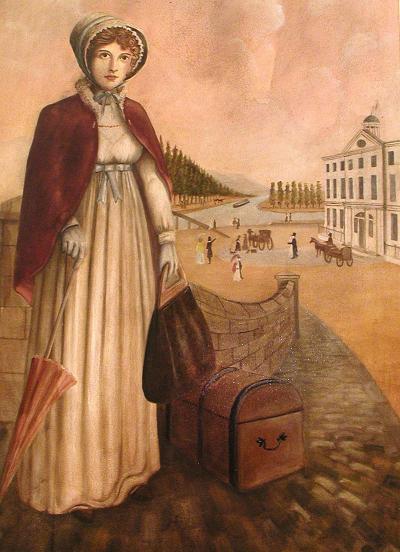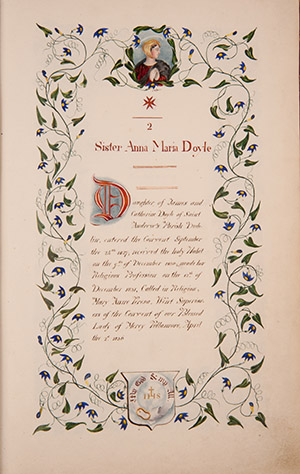![[thumbnail] Bonnie Brennan rsm](../_uploads/resources/authors/146-fce0548b/FCE41090-2219-A8B0-B6ACEB06F8461B8E.jpg)
Mary Ann Doyle
A biography written by Bonnie Brennan rsm
The first young woman to offer her services to Catherine McAuley in her efforts for those who were poor, was Anna Maria Doyle. Strange as it may seem Anna Maria had never met Catherine when she requested an interview with her in the Spring of 1827. Afterwards, summing up this first meeting Anna Maria said simply, “we were much pleased with each other”.
 Anna Maria Doyle was born in Dublin, at 15 St. Andrew Street on August 6, 1801. Her parents James and Catherine Doyle were devout Catholics and, because of their adherence to their faith, suffered the fate of most Irish Catholics of the time: a drastic change in financial circumstances. James Doyle was a silk merchant whose business rapidly declined and left his young family on the brink of poverty.
Anna Maria Doyle was born in Dublin, at 15 St. Andrew Street on August 6, 1801. Her parents James and Catherine Doyle were devout Catholics and, because of their adherence to their faith, suffered the fate of most Irish Catholics of the time: a drastic change in financial circumstances. James Doyle was a silk merchant whose business rapidly declined and left his young family on the brink of poverty.
Anna Maria’s sister, Catherine, had become a Presentation Sister in Killarney, and Anna Maria’s initial desire was to follow her lead. However, it was not possible for her parents to come up with the necessary dowry. Subsequently, when her brother, James, became a priest in the Dublin Diocese he offered to pay £40 a year to the Presentation Convent in Maynooth for Anna Maria to fulfil her dream. Then disaster struck! Just as Anna Maria was about to enter Fr. James died suddenly from typhoid, contracted as he ministered to one of his parishioners. Anna Maria had one other brother, John, who became a renowned Political Cartoonist (under the pseudonym H.B.). Since John and his family had moved to London in 1820, Anna Maria was now the only member of the family remaining at home with aged parents. The idea of becoming a nun, with the strictures of enclosure, had to be abandoned. We now know that there was a providence in all the preceding sad events. It was while out walking with her parents along Baggot Street one evening that the strange new building under construction caught their attention. When the purpose of the owner, Miss McAuley, was explained to Anna Maria she determined to seek the introduction mentioned already.
When the building on Baggot Street was completed Catherine McAuley was not free to take up occupancy due to the death of her only sister, Mary, Mary had five young children whom Catherine wished to look after for a time. Catherine was, however, delighted to suggest that Anna Maria and Catherine Byrn should take up residence, at Baggot Street, so that the good works might begin. To quote one of the early biographers of Catherine McAuley, ‘Miss Doyle was in immediate charge, Miss McAuley in remote control - though not too remote, for she came each day... and entered into the business going on’.
Catherine and Anna Maria were two very different people in character and disposition.
Catherine was witty, fun-loving, casual and free. Anna Maria, on the other hand, was shy, timid, cautious, serious and somewhat withdrawn in disposition. However, the blend of their gifts was to provide a very balanced foundation for the Institute of Mercy which emerged.
Anna Maria was chosen to accompany Catherine and Elizabeth Harley to the Presentation Convent, George’s Hill, to make preparations for the founding of a new congregation - the Sisters of Our Lady of Mercy. Anna Maria Doyle now became Sister Mary Ann. Later she became Mother Assistant to Catherine in the administration of the new Institute. In March 1835, Catherine named Mary Ann as Superior of the first branch house opened in Kingstown.
 The following year, in response to the first request for a Mercy community to be made from outside Dublin, Mary Ann was again asked to pick up her roots. She set out for Tullamore, County Offaly, on April 21, 1836. She and one novice were to form the basis of the new community! Two other novices, one of whom was the young Catherine McAuley, niece of the foundress, were given ‘on loan’ to help get the new project off the ground!
The following year, in response to the first request for a Mercy community to be made from outside Dublin, Mary Ann was again asked to pick up her roots. She set out for Tullamore, County Offaly, on April 21, 1836. She and one novice were to form the basis of the new community! Two other novices, one of whom was the young Catherine McAuley, niece of the foundress, were given ‘on loan’ to help get the new project off the ground!
In no time at all three young local women came to join the Sisters of Mercy. These early days in Tullamore were to become Mary Ann’s first real testing period, but, she rose to the challenge. She was, simultaneously, superior of the community, directress of novices, and mistress of schools! In the first summer in Tullamore Mary Ann conducted the Annual Retreat, according to the Exercises of St. Ignatius of Loyola.
As the Sisters of Mercy spread to other parts of the country Mary Ann had the pleasure of six visits from Catherine between 1836 and 1841. During this period the community had grown, a new convent and school were built, and Catherine was delighted to see these development at first hand. Apart for the fact that the Tullamore group had not yet spread its wings, Catherine was very pleased with the progress of her first independent foundation
It was not until after Catherine’s death that a group of Sisters was sought from Tullamore, for Kells in County Meath. Ireland was now on the brink of the Great Starvation that was to have devastating effects throughout the country. Nonetheless Mary Ann, and two other sisters set out for Kells on February 9th, 1844. They travelled the fifty mile journey by open sidecar and arrived at their destination at 3.00 p.m. We can only guess at the unearthly hour at which they said their sad farewell to the community in Tullamore!
In Kells schools had already been built, through the benevolence of Catherine Dempsey who left her fortune ‘for the education and clothing of the poor children of Kells.’ Besides teaching in these schools, the Sisters soon set about visiting the poor and sick in their homes and found the living conditions appalling. Soon began another service that of ministering to those whom poverty had driven from their homes, and who now inhabited the local Work House. One is left to wonder what became of the reticent, shy, backward Mary Ann as she rose to all those challenges.
.jpg)
In 1847 Mary Ann, in failing health, returned to Tullamore - to live out the remainder of her life in relative seclusion. So much for dreaming! In November of that same year Dr. Maginn of Derry approached the Baggot Street community for a foundation for his diocese - he was referred to Tullamore. To make a long story short Mary Ann was one of six Sisters who headed northward on July 18th, 1848. This time she agreed to go as Assistant to Catherine Locke (her first postulant in Tullamore in 1836). Mary Ann would also fulfil the duties Mother Assistant and Mistress of Novices.
Four years later a dilemma in Omagh demanded that a community of Mercy Sisters be established there with great urgency. Once more Mary Ann found herself being one of the group - this time she was leader once more - but the sojourn in Omagh was of short duration. When a community of Loreto Sisters was available to replace them the Sisters of Mercy returned to Derry.
From 1854 -1866 Mary resided in Derry - though in failing health for many years she was a great support to all the Sisters as she encouraged them to live according to the spirit of Catherine McAuley. The Sisters were delighted to have this link with their foundress and felt that they came to know her through Mary Ann.
In the Summer of 1866 was Mary Ann was invited to spend some weeks in Moville, in the hope that the bracing sea air would restore her health. But in August she experienced a strong desire to return to Derry.
Death came to Mary Ann Doyle at 2 o’clock in the morning of September 11, 1866.
Obviously a special place had been reserved for her burial for we are told: 'In the first compartment of our vaults the hallowed remains of Mother Mary Ann rest in the very centre, while above her, below, and on either hand, were laid fourteen young forms, not one of them in their thirtieth year, most having died in their twenties’. (Derry Annals)
Reference
I am aware that this is a very sketchy account of the life of Mary Ann Doyle. Should the reader be interested in fleshing out her story, and her very valuable contribution to the establishment of the Sisters of Our Lady of Mercy, a more comprehensive account of her life may be found in, “It commenced with two…” - The Story of Mary Ann Doyle, First Companion of Catherine McAuley - published by the Sisters of Mercy of the Northern Province, in 2001.

